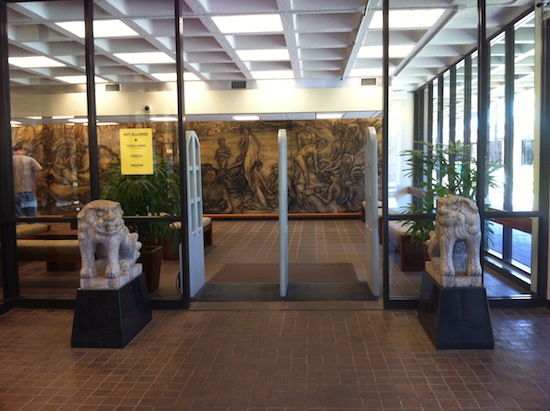Two lion-dogs stand guard at the entrance to Hamilton Library, located on the University of Hawaii at Manoa campus. I walked past them every day for a year before noticing that they are not exactly identical. And, in true Hawaiian fashion, they have many local cousins. Called koma-inu, these statues were brought from Japan in 1924 for the Shinto Inari Shrine on King Street. In 1942, after the outbreak of World War II, they were given to the university.
The stylized dog-lion appears in various art forms in many countries, including China, Japan, Korea and Tibet. They are spirit guardians and protectors. The male is on the right as you face them, the female on the left. Some of the most ornate statues I’ve seen locally are the small ones at the entrance to an inner courtyard at the Honolulu Museum of Art.
In China, they are called shishi or Fu Dogs (sometimes “Foo Dogs”). Placed in pairs at imperial palaces in historic times, they now are common at entrances to restaurants and other buildings. The male lion-dog has one paw resting on a ball, and the female has one paw on top of a cub lying on its back. Two huge statues face one another across Hotel Street at the entrance to Chinatown from downtown Honolulu. They were a gift from Kaohsiung, Honolulu’s sister city in Taiwan in celebration of the 1989 bicentennial of the arrival of Chinese in Hawaii.
A pair of Fu Dogs stands at the makai and mauka ends of Jefferson Hall at the East-West Center, also located on the university campus. It was a gift from Taiwan in 1971 at the request of Chinese students. Their heads are turned toward one another, and both have one paw on a round ball. If you look closely, however, there is a clear gender difference.
The statues are called shisa in Okinawa, where there are two types of guardian lion-dogs. Unlike their Chinese cousins, they have both feet on the ground. Large figures are placed in pairs at entrances; the left with a closed mouth, the right opened. One legend has it that the open mouth wards off evil spirits while the closed mouth keeps good spirits in. Other stories are that one is inhaling and the other exhaling, representing life and death. The shisa at UH-Manoa are a gift from the University of the Ryukyus, created especially to commemorate the creation of a Center for Okinawan Studies at UH.
Along with the large shisa seen at entrances, there is also a small shisa placed on a house roof. The roof shisa may be made of stone, plaster, china or wood and is believed to protect the house from fire, as well as keeping evil spirits away. I was excited to spot one of these recently on a house in Kaneohe. Ordinarily, we would have passed too quickly for me to notice, but traffic was stalled due to the Christmas parade, so I had time to look around.
Now that I know a little about the history of these statues, I enjoy looking at them to identify the subtle differences. They pop up in the most interesting places in Hawaii!




